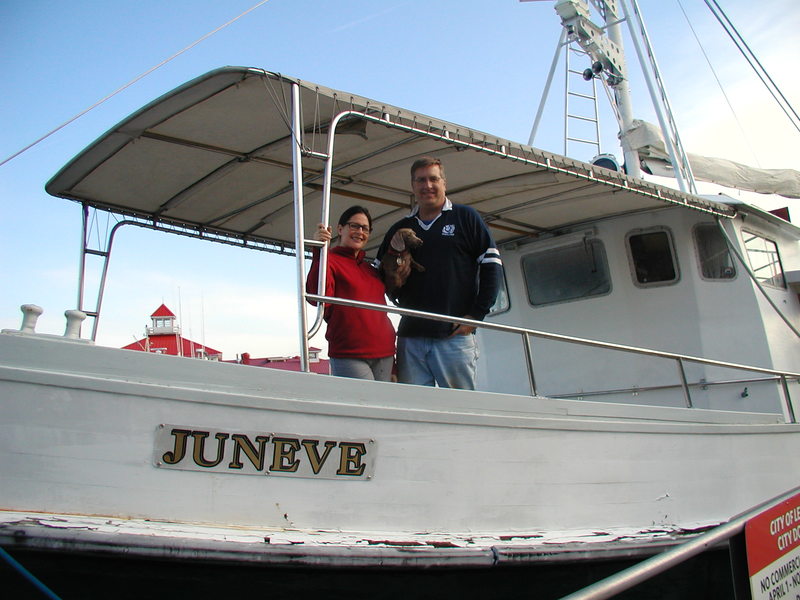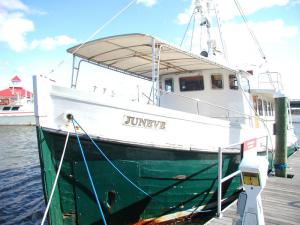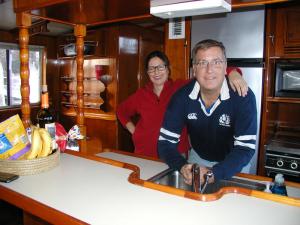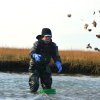Wooden-boat skipper discovers Lewes
When Craig Butler shoved off from a dock in New York aboard Juneve, he didn’t know the yacht he had just purchased was on a serendipitous course for Lewes, perhaps leading to the place he and wife Rebecca Maywald might someday call home.
“This boat is pretty much what brought us together. It was part of our dream, to own a boat one day,” Maywald said. They found that living aboard a boat was their common desire when they first met in Olde Town, Portsmouth, Va.
Built in Scotland in 1949, Juneve was designed to be a North Sea trawler, which she was for many years. The boat was exactly what Butler and Maywald had been looking for - a wood-hulled vessel they could live aboard.
After searching for about two years, they found Juneve on the internet. “She was built basically bulletproof,” Butler said. She had been sitting in Cold Spring Harbor, Long Island, N.Y., for some time.
The freshwater harbor wasn’t the best place for the oak and larch boat hull, Butler said, but she was better off there than sitting in a cradle on land, where wood dries out.
“I purchased it from an estate. We’re going to restore her back to the yacht-finish,” Butler said of the job of his Australian-born wife.
Both experienced mariners, the couple married last year in New York aboard the Tall Ship Clipper City.
Rebecca is a freelance chef who has traveled the world visiting more than 48 countries working aboard private, luxury yachts she calls “giant Clorox bottles.” “They’re owned by people who have more money than God,” Maywald said. She’s an internationally certified shipmaster, trained to operate certain size vessels.
Her sailing experience includes two Atlantic Ocean crossings. “I’ve been yachting on and off for about nine years,” she said.
Butler started sailing when he was 11 and sailed competitively throughout his teen years. During summer, when school was out, he earned a captain’s license and had a job delivering yachts. He served as a first mate aboard tour boats and a part-time captain aboard a Portsmouth ferry. He and has also sailed his own boat up and down the East Coast and to the Bahamas, Bermuda and back.
His job is ensuring that container ships are properly loaded for balanced cargo weight distribution and ballasting. Containers are loaded according to what’s in them and must be loaded in the right order for port stops.
Juneve’s past
At 62 years old, Juneve has traveled thousands of nautical miles and has had several owners. The boat is 65 feet long, has a beam of 19.5 feet, a water draw of 8.5 feet and an air draft - the distance from the water line to the top of the mast - of 35 feet.
The boat builder named the vessel after one of his daughters.
Butler said a Danish boat builder purchased the vessel from the Scotsman, and he bought it to the United States where it was converted into a yacht.
In the 1960s, the boat went through about four refits, and in the early ‘80s, a boat builder from Norway purchased the vessel and restored it, Butler said. He said knowing two boat builders had previously owned Juneve was significant. “They wouldn’t have owned something that was a piece of junk,” Butler said. He said the Norwegian boat builder died, and Butler talked with his son for a couple months before going to see the vessel.
“He had prostate cancer, and they gave him two years to live. His father lived seven years because of this boat. He poured all his time into fixing this boat up, and that’s what kept him going,” Butler said.
He said after the man died, his family took care of Juneve for a while, but it later fell into disrepair.
Juneve is St. Croix-flagged because the previous owner also owned several boats and marinas there and in Florida, New York and Connecticut, Butler said. He said they would re-flag the boat as a Virginia vessel, but they haven’t decided on a city. In the not-too-distant future, Juneve could return to Lewes with a new name and under a Delaware flag. The couple said they don’t adhere to the belief that renaming a boat leads to bad luck. “I believe in some boat superstitions, but not that one,” Butler said.
Checking out and buying the boat
Butler said Juneve’s owner had two other offers on the table from people who planned to dismantle the boat. “They were going to take all of the wood from the hull and resell it for flooring for homes,” he said.
Butler said the boat builder’s son had very well maintained the vessel’s original, 1949 engine. “It’s a Gardner diesel, straight, in-line eight cylinder, 230-horsepower. There are several collectors of Gardner diesels and he was considering selling the main engine to one collector and also selling off the generators,” he said.
Butler said the son couldn’t bring himself to sell the boat as salvage, because it had been a labor of love for his father. He sold it to the couple because they would restore and take care of it.
“And for the price, we just couldn’t say no. He knew we would love and care for it. At the very least I figured we could get this boat thing out of our system,” Maywald said. With the previous owner aboard, they cruised from Cold Spring Harbor to Liberty Landing, N.J., down the East River and around Manhattan, where the previous owner got off.
The vessel has a 9,000-gallon fuel capacity. Aided by a single-mast steadying sail, Butler said Juneve is built to go around the world.
“Theoretically, this boat could go around the world twice without stopping for fuel.” he said, adding the couple has no circumnavigation travel plans.
The boat is also equipped with two generators and has redundant systems throughout, including two radar units, two GPS units, an old LORAN-C used to double-check GPS coordinates, autopilot and a fish finder.
Something they didn’t need was a Hammond electric organ that had been installed adjacent to the galley. The previous owner’s 85-year-old widow was sad to see the boat and organ go, Butler said.
“She said, ‘Oh, I’m going to miss playing the organ so much,’” Butler said. He said he told her son neither of them play the organ. “I said how about we take the organ off the boat and put it in her sunroom and surprise her. So we took it off and, unbeknownst to her until two days later, when she went in the sunroom, there was the organ. It made her happy,” Butler said.
Juneve has a single, 4.5-foot diameter propeller, which Butler said makes her somewhat difficult to maneuver in tight places.
“She handles like a full-keel sailboat. When you back her down, you’ve kinda let her do her own thing. You’ve got to read the current and read the wind. She’s got a mind of her own,” he said.
Juneve breaks down
With Butler at the helm and one friend as his crew, the men headed south. “We took off the next morning. We had traveled about 40 hours and were off Atlantic City. The forecast at that point was for winds gusting up to 15 mph, with seas of 2 to 4 feet, which was fine. When we got to the mouth of the Delaware Bay, it was a different story,” Butler said. He said winds there were gusting to 30 mph, seas were 6 to 12 feet and the boat continued to cruise beautifully.
He said because the hull had been dry above the water line, seams opened allowing water to enter. “Most of the water we ended up taking on was when we were being towed in,” he said. He said water was forced up through the hawse pipe - a metal pipe the anchor line passes through – and into the anchor locker. He said pumping the water out wasn’t a problem.
“But the little bit of rocking we were experiencing stirred up the gunk on the bottom of the tanks.” Butler said. The debris damaged the engine and generator, causing both to quit.
“We had to get TowBoatU.S. to tow us in,” he said. The vessel was first towed to Anglers Marina where they planned to lift it out of the water. Butler said the marina’s lift is rated at 75 tons. “We got her about a foot-and-a-half off the water but she was just a little too much,” he said. He said the vessel’s U.S. Coast Guard registration states it weighs 64 net tons. “With fuel, water, lube oil, various equipment and stairs, we estimate her to be closer to 82 or 83 tons,” he said.
They moved Juneve to the City Dock where a mechanic is doing a fabulous job on the boat’s engine. Butler said he thinks he might be underway again this week and plans to resume travel to Norfolk and on to Atlantic Yacht Basin in Chesapeake, Va., where the company will begin restoration.
Butler and Maywald practice safety first. “Safety’s no accident,” Maywald said. They plan never to sail more than three miles offshore, which means cell phones can still be used. They also carried a satellite phone.
“We also have a good friend who’s in the Coast Guard, so I was getting coordinates every half-hour, so I knew where they were in case things went pear-shaped,” Maywald said, using Australian slang meaning everything is going to hell.
She said things would have to go very badly to need a life raft. “You’d have to sink the boat, really,” she said. “You always want to step up into a life raft, you never step down because the best life raft you have is your boat. It’s bigger and it’s easier to see. There have been a few incidences where people have stepped down into a life raft and been lost, when the boat was still afloat,” Butler said.
Loving Lewes
“Everybody in this town has been so gracious and so nice,” Butler said.
Maywald said Lewes is the antithesis of what one would expect a small, country town to be, and she has fallen in love its Second Street shops and restaurants.
“We’re going to live on the boat, and we figure with what we could save by not having a mortgage payment, we could use to build a little architectural jewel here in Lewes in a couple of years’ time, and we’re going to call this home,” she said.
The couple said it will about a year before Juneve is ready to live aboard, and they might already have a buyer for their Portsmouth home.
In the meantime, the mariners might find time for further exploration of the First Town in the First State.
“I do a lot of work in Martha’s Vineyard, Nantucket and St. Tropez, all of the cute little coastal towns all over the world. I just can’t believe a place like this exists, and it’s not on the map,” Maywald said.
























































